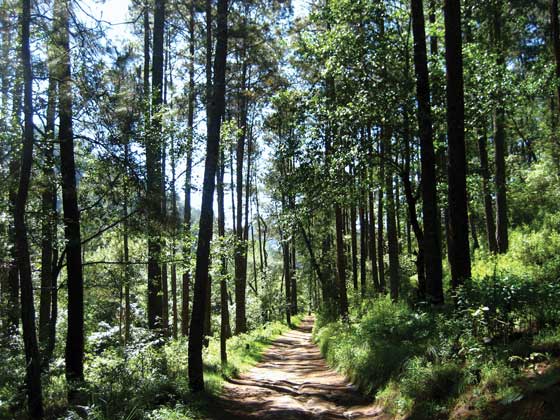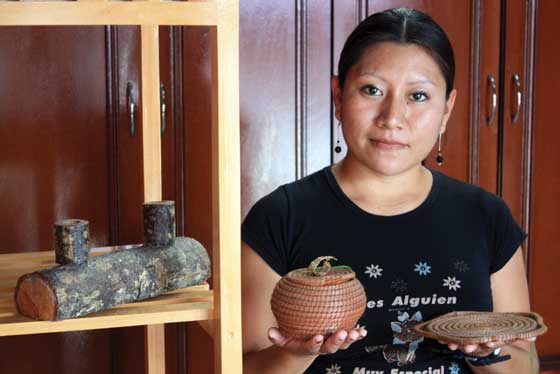Heart of the Forest
Showcases Mushrooms and Temescales
If snack wrappers blemishing the Guatemalan countryside dishearten you, take heart. There are places you can go where litter is not only unseen, its demise is being plotted.
They are snapshots of Guatemala’s glory before the modern container revolution. And, primero Dios, they are foretastes of the coming restoration of that glory.
The revolution in question sprung upon Guatemala only a generation ago. Sugary drinks, salt-laden crunchies and puffed pig fat began appearing on tienda shelves, attired in zany, mass-market packaging. They were still a poor value, but at least cheap enough to be occasionally within the reach of almost everyone.
Unlike a banana wrapper, however, these synthetic skins had a way of sticking around long after their usefulness. Indeed, those discarded 30 years ago are still with us, marring roadsides and bulking out clandestine dumps.
“One reason,” says Brittany Sickler, “is that people may take for granted that such packaging [unlike organic peels, etc.], decomposes.”
The North Dakotan Peace Corps volunteer says that she herself goes to the mercado and buys blocks of cheese and other foods wrapped in “organic” packaging like milpa leaves.
Sickler labors alongside Guatemalans at the Corazón del Bosque (Heart of the Forest) reserve in the village of Novillero, at kilometer 145 on the Panamerican Highway. This education and reforestation center, which covers about 40 hectares in Sololá Department, is one of eight such projects in the province. They operate through the cooperation of several governmental agencies with Vivamos Mejor, a Panajachel-based NGO.
Most of the reserved areas are in lakeshore communities such as Santa María Visitación, with the one in Novillero being an exception. The Novillero site, however, is an ideal showcase for the entire campaign, located as it is on the most-traveled highway in Guatemala. Garbage is nowhere to be seen—save for in receptacles, and even most of that is sorted onsite for recycling.
The presentation at the education building is targeted to schoolchildren, whom the educators consider the conscience and future of Guatemalan environmentalism. It begins with a video of a puppeteer mimicking a whimsical bird with his own painted hands. The bird, unfettered by limits of time and space, shows the wasteland that Guatemala might become if erosion and deforestation continue unabated. This is followed by an orientation to tree planting, technical yet geared to young minds.
The youngsters are then taken to an area where a special hole in the ground has been prepared for each one, and given a tree—pine, cypress, broadleaf oak or the endangered pinabete—and allowed to put their learning into practice.
Vivamos Mejor executive Estuardo Girón speaks of the eight reserves as a circuit that he expects nature aficionados will someday follow. He admits that not all of the other seven “bosques” are as developed as the Novillero one. But eventually, he foresees all of them boasting a similar array of attractions.
Aside from the education center, these include nature trails, rental cabins, a restaurant, picnic areas, a playground, herbalist and cooking classes, appropriate technology exhibits, Mayan altars that are in regular use, nurseries for trees and edible fungi, and a line of handicrafts featuring such unique items as vases woven from pine needles. The restaurant offers international, típico and vegetarian fare; there is even rabbit creole and a locally famous mushroom entrée prepared by the chef, “Grandma Rosa.”
One of the appropriate technology applications saw a setback because of the May rainstorms.
“We actually had a miniature hydroelectric project,” says Sickler. “It was not only a learning tool, but it provided about half of the electricity for Corazón del Bosque.”
Sadly, the rainstorm breached the little dam that was built across the small river crossing the bosque. But the other appropriate technologies on display are still up and running, such as small animal husbandry and wall construction using bottles filled with—what else?—snack wrappers. This latter form of reclamation has long been pioneered by German activist Susana Heisse, founder of the bosque reserve in San Marcos la Laguna.
The presentations are given to visitors on a drop-in basis, but perhaps the best way to experience the Corazón del Bosque is to overnight there at one of the cabins. These are at the end of trail, in the pine-scented heights. Each has an attached private temescal, or Mayan sauna, in the form of a dome made of stones. The cabins also have kitchenettes and outdoor dining facilities. Children are reported to love the three-level bunk beds.
For more information about visiting or volunteering at Corazón del Bosque, call 7723-4140, or go to www.corazondelbosque.com

